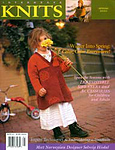patterns > Interweave Knits >  Interweave Knits, Spring 2000 and 3 more...
Interweave Knits, Spring 2000 and 3 more...
> Fairy Tale Scarf



Fairy Tale Scarf
Interweave SKU: EP0047
A bleeding-heart lace pattern goes on and on in this trailing scarf fit for a fairy tale (Interweave)
Finished Size: About 13” (33 cm) wide and 90” (229 cm) long, blocked.
Yarn: JaggerSpun Zephyr 2/18 (50% silk, 50% Merino; 5040 yd (4608 m)/lb): #M0328 vanilla, 2 oz (55 g).
Yarn weight: #0 - Lace
Gauge: 20 sts and 30 rows
Needles: Size 4 (3.5 mm). Adjust needle size if necessary to obtain the correct gauge.
Notions: Markers (m); tapestry needle.
Originally Published: Interweave Knits, Spring 2000
Pattern Description from Interweave Online Store: “As a knitter and weaver, Sarah Swett is constantly bouncing back and forth between her needles and her loom. On rare occasions these two spheres intersect. Such was the case when she designed Hands, a mixed-media 24-by-21-inch artwork that depicts, in weaving, a woman and two children walking along a river holding hands, two large hands looming over them in the process of knitting, holding real Brittany knitting needles and a real piece of lace (see Interweave Knits, Spring 2000). Sarah spent a lot of time swatching lace patterns in order to find just the right one for the tapestry (it had to be extremely open in order for the viewer to be able to see the tapestry images beyond) and resolved, once she was done, to knit something “real” using her favorite pattern from the swatching process (which wasnt the netting pattern that worked best for the tapestry). The favorite pattern is called Bleeding Hearts and comes from Barbara Walkers Charted Knitting Designs (Schoolhouse Press, 1998), and the scarf presented here is the “real” project that followed the tapestry. “For several years I watched those hands on the wall busily knitting and getting nowhere until, at last, I knew it was time to finish their work,” Sarah explains. The scarf begins with an invisible cast-on and a small strip of the faggot border. Center pattern stitches are picked up and knitted along the straight edge of the border, followed by the invisible cast-on stitches. From that point on the center pattern and border stitches are knitted at the same time.“

11091 projects
stashed
10044 times
- First published: March 2001
- Page created: September 24, 2007
- Last updated: July 30, 2024 …
- visits in the last 24 hours
- visitors right now





